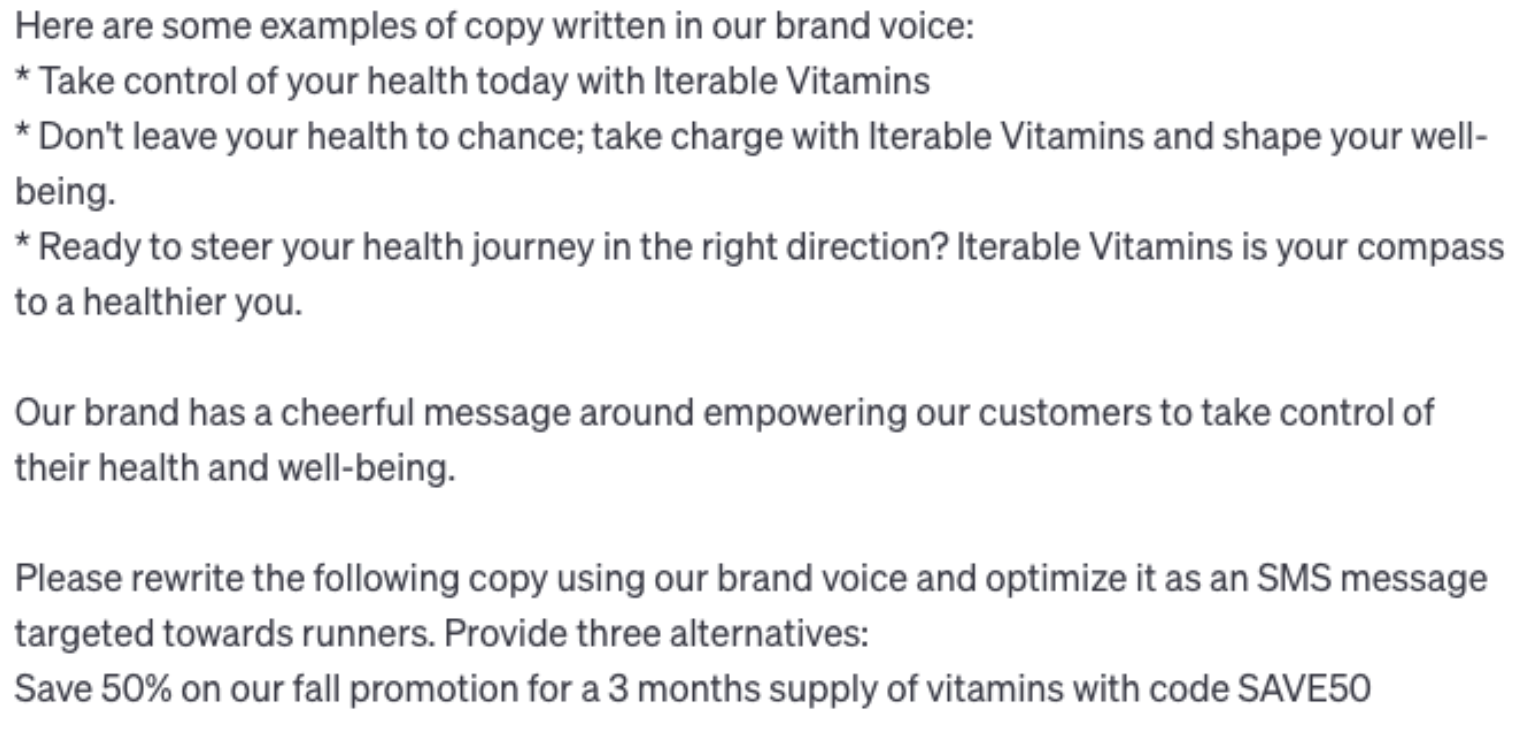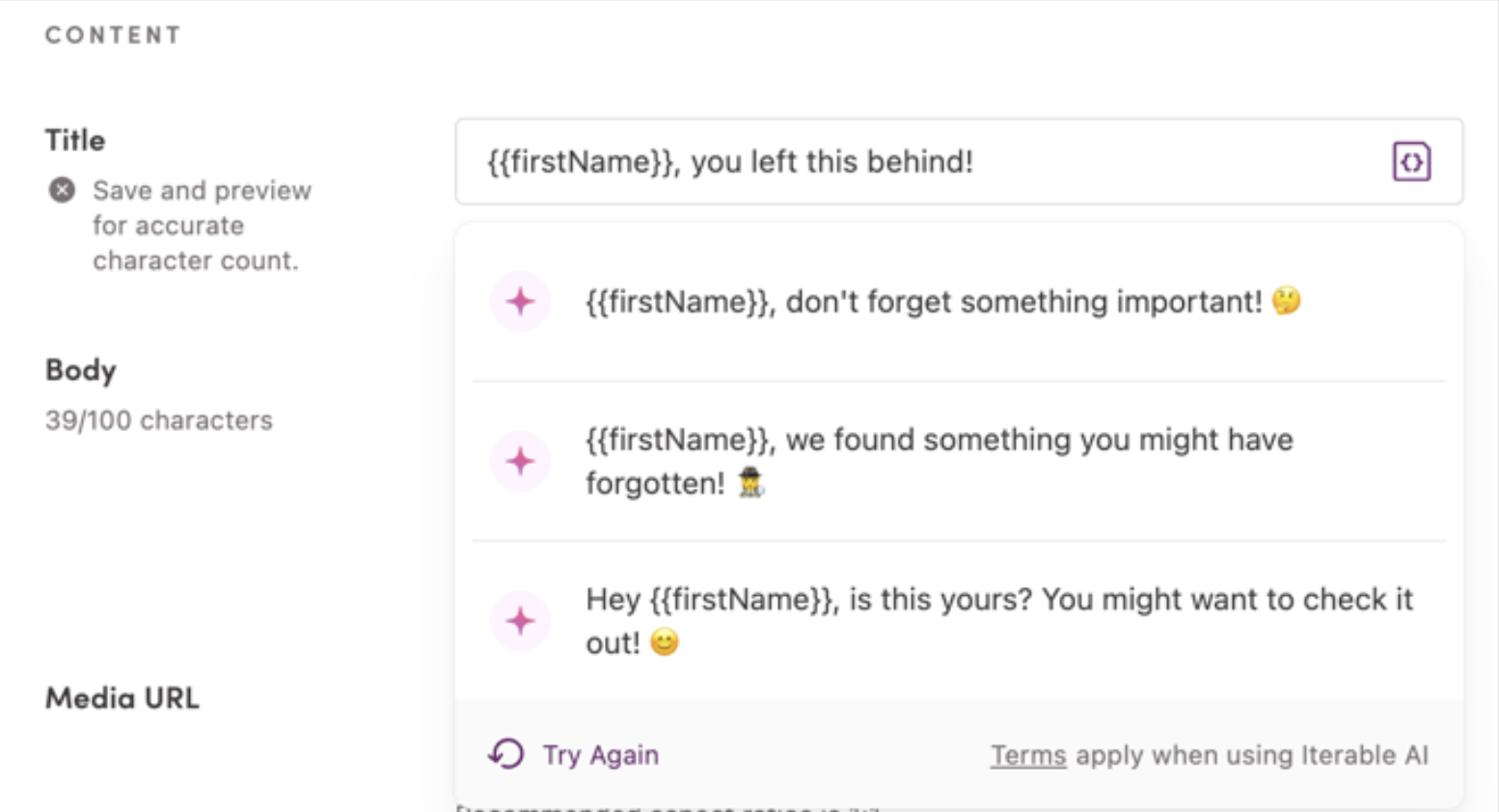Like any technological innovation, artificial intelligence (AI) is only as effective as the people behind it, and the success of AI marketing often hinges on the quality of the information provided.
This information involves the following elements:
- A Large Language Model (LLM) is “a specialized type of AI that has been trained on vast amounts of text to understand existing content and generate original content.”
- An AI prompt is an input that instructs a large language model (LLM) to deliver a specific output, such as, “Generate a list of email subject lines with friendly tones that offer up to 50% off all items for a fall promotion.”
- AI seed copy is messaging you can include with your prompt to provide examples and needed context that the LLM can iterate on. With the above AI prompt, for example, the seed copy could be “Save 50% on Fall Promotions This Week.”
In other words, this information is crucial in bridging the gap between where you are and where you want to go with whatever you’re using AI to achieve.
And it’s not easy. With the rise of AI has come a momentous rise in the demand for AI specialists, including a new role known as AI Prompt Engineers. Yes, there are people who specialize in crafting the AI prompts that deliver the most impactful results. So, if you’re finding it challenging, don’t beat yourself up.
While we’re not all AI Prompt Engineers, when it comes to AI-generated marketing copy, there are some tricks for optimizing your prompts and getting to the finish line faster and more effectively.
So, without further ado, here are five tips to enhance your AI prompts and seed copy to build better AI marketing campaigns.
1. Familiarize Yourself with AI Functionality
While the use cases for AI in marketing are vast, the actual applications of it will depend on the platforms you use. Before you type a single word, it’s valuable to know the basics of an AI tool, including:
- What kinds of messaging it supports
- The minimum and maximum number of characters it can input and output
- Whether it’s optimized for your native language
- Any limitations on how content will be generated
Once you understand the underlying foundation of how an AI solution functions, you can be better equipped to start your AI campaign development off on the right foot.
2. Understand Your Target Audience
One major factor that’s lacking in most AI-generated copy is context, and no one understands your target audience better than you. Make sure your marketing team is aligned on customer needs, interests, preferences, and pain points.
For example, while there are millions of users in North America who use Redfin to buy or sell their next home, only a small percentage are active, meaning they’ve engaged with an email or visited Redfin.com in the last 30 days. The retention marketing team needed to identify which inactive users were most likely to convert and activate that segment with personalized, conversion-oriented communications. They leveraged Predictive Goals, an Iterable AI product, to understand which inactive sellers were most likely to convert to an active state if targeted by messaging, and were able to achieve a 72% lift.
Once target audiences are identified, brands can take that into consideration when drafting prompts and seed copy so the LLM will be more likely to create messaging that resonates with them.
Getting crystal clear on who you’re speaking to in your marketing messaging will make your customers more inclined to listen.
3. Keep Your Brand Voice Top of Mind
After you’ve agreed on who you’re communicating with, the next step is to decide on how you’ll be communicating to them. For consistent AI marketing campaigns, incorporate your brand’s voice into your seed copy or prompt. This will help AI tools generate copy that feels authentic and true to your brand’s identity.
To hone in on your brand voice, consider the following elements:
- Personality attributes you want to emulate
- Your goals and objectives with various types of content
- Your company’s writing style across mediums
- The tone of corporate written, visual, and video content
- Guidelines for grammar, mechanics, and even emoji usage
For example, here is a prompt a hypothetical Iterable Vitamins business might use to customize an SMS message:


An example of an AI prompt a vitamin business may use for SMS copy.
The LLM yields a response of:


The results from the above AI prompt with three different subject line examples.
When writing a prompt, consider providing:
- Messaging examples that exemplify your brand voice
- Instructions about the intended tone
- Seed copy that clearly expresses the intent of the copy and let the LLM optimize it for you
Ultimately, these elements help you determine how your brand would be characterized if it were a human being. The more specific you are with these characteristics, the more naturally an AI will be able to replicate them.
4. Don’t Forget to Personalize
AI at its worst is utterly generic, creating content that’s like a carbon copy of a carbon copy. At its best, it can empower brands to personalize their content to improve their rapport with customers. Thus, it’s even more important to humanize your communications to build a rapport with customers.
Most AI-generated copy is based on the text you provide, rather than on specific campaign or user data, but that doesn’t mean you can’t earmark opportunities for personalization. For example, let’s say we want to target runners. Here is how we might adjust our previous prompt:


Edited the prompt to include “using our brand voice and optimize it as an SMS message targeted towards runners.”
This yields the following responses, which are tailored to runners specifically:


Adjusted results that offer three new SMS options geared towards runners.
Smart AI prompt customization can help you tailor your messaging to your audience by personalizing your copy for their interests.
5. When in Doubt, Iterate
One of the advantages of AI in marketing is the ability to quickly generate a plethora of variations. AI marketing platforms are designed for iteration, because they’re learning from your inputs and adapting their outputs accordingly.
Even if your seed copy or prompt isn’t ideally constructed, you can test multiple variations until you land on a winning option that will resonate best with your audience.
Enter Copy Assist
Now that you’re up to speed on crafting AI-generated marketing copy, you can put your insights into action. A great tool to implement into your campaigns is Iterable’s Copy Assist, which is specifically designed for short message copy, such as email subject lines and message text for SMS and push notifications.
Copy Assist is especially useful for providing alternative text suggestions based on the seed copy provided. It quickly generates numerous options and variations as it learns in real-time from the seed copy you’ve entered recently.
Moreover, if you’re already familiar with using handlebars in Iterable to personalize your communications, they can be used as placeholders in Copy Assist. All you need to do is verify the accuracy of any handlebars expression that’s included in the generated text before publishing it.


Iterable’s Copy Assist generates assistive text, including any handlebar personalization you input.
With Copy Assist, you get a helping hand with your marketing campaigns, enhancing and expediting the process from input to inbox.
AI Starts With You
The prompts and seed copy you input into AI platforms play a pivotal role in the success of your marketing campaigns. As convenient as it may sound to hand over the keys and let a robot take the wheel, it’s worth investing the time and effort to ensure any AI-generated copy represents your brand’s voice and effectively connects with customers. With these tips in mind, you can take your AI marketing from mediocre to magical.’
Looking to enhance and expedite the process of writing copy for your marketing campaigns? Ask for a helping hand and schedule a custom demo of Iterable’s Copy Assist today.
































